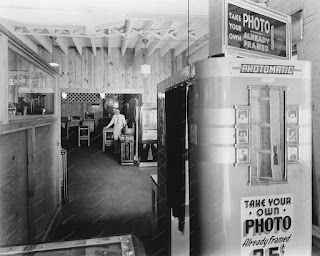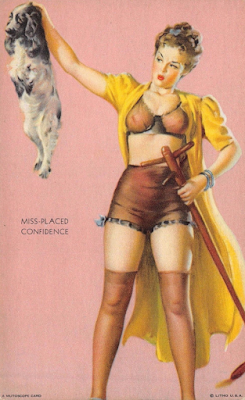Jim Linderman blog about surface, wear, form and authenticity in self-taught art, outsider art, antique american folk art, antiques and photography.
The Unusual (and bizarre) work of Tom Yab aka Cobb Shinn
Forgotten illustrator Cobb Shinn! The first image is a heavily embellished postcard from 1913. It is most unusual to see a painting added to a printed postcard, but this is certainly one of the craziest..the reverse is odd too, but I'm not scanning it. An original card is shown below it. Tom Yab drew Yab's Kids, but so much more...and the best place to learn about him is on the Tattered and Lost website HERE. It's great.
Hand-painted Cobb Shinn postcard 1913 Collection Jim Linderman
Antique Colors of the West Coast Turn of the Century NITROKOTE
Don't paint it, NITROKOTE it! W.P. Fuller put out Nitrokote in the early 1900s. Fuller was the largest paint supplier on the West Coast. I guess you could say he was the Fuller Brush Man with a painting brush. Today when you see old paint on furniture and objects from the Pacific coast, it might have been Nitrokoted!
Salesman Sample color brochure Nitrokote Paint Collection Jim Linderman
Kenneth Hetrick Fills the Skies. Bulbuous Airships in Yellow
Army Plnes (Planes) by Kenneth Hetrick 1931. Collection Jim Linderman
You may also enjoy ECCENTRIC FOLK ART DRAWINGS OF THE 19TH AND 20TH CENTURIES The Book and Ebook
Superman reveals his secret Michigan origins Vintage Woodward Avenue Parade Float
Towering over Woodward Avenue is M man, brother to Superman and representing the planet University of Michigan! Woodward is Detroit, and the parade began in 1924.
Original Miniature Snapshot Collection Jim Linderman.
Thanks and a tip of the huge balloon to Curley's Antiques.
19th Century Folk Art Portrait Drawing
19th Century Folk Art Portrait Drawing Collection Jim Linderman
You may also be interested in ECCENTRIC FOLK ART DRAWINGS OF THE 19TH AND 20TH CENTURIES available as a paperback or an ebook HERE.
Not unless you have a warrant (and say hello to the whirligig when you leave) 1959 Vernacular Folk Art Photograph
Not unless you have a warrant (and say hello to the whirligig when you leave) 1959 Vernacular Folk Art Photograph COLLECTION JIM LINDERMAN
Rubber Stamp Hair A Dame with Nothing on her Mind but Dates
November 16, 1941 Rubber Stamp Hair. Caption "Ever see a dame with nothin' but dates on her mind?" Drawing by Willard Fitzgerald 1941 Collection Jim Linderman
You may also be interested in the book (and cheap ebook) ECCENTRIC FOLK ART DRAWINGS OF THE 19TH AND 20TH CENTURIES.
How to Read a Tintype
How to read a Tintype? Tintype photographs were created (and are today found) with a mirror image. That is, they reversed reality. To "read" a tintype with text, scan it and use your computer tool to flip horizontal.
"Tickets" Tintype circa 1880 Collection Jim Linderman
Honoring the Photomatic Photograph Machine Your Selfie ALREADY FRAMED
Let's take a minute to thank the International Mutoscope and Reel Company! No one provided better value for your time and your dime. Photomatic photographs are but one example of their product line, but the one which is the most fun. An early robot with an eye. The company also had the horrible taste to produce "The Atomic Bomber" in 1946, unfortunately. They called it "timely" as the radiation hadn't yet dispersed.
Photomatic machines were plopped down where folks killed time. Railroad stations mostly...and the same places Starbucks wedges their six dollar a cup baristas today. The company created numerous "peep-show" type things which were among the first general circulation machines to display moving pictures. Drop a coin, peer in and see something you think you never saw before! Often "what the butler saw" type things. Mutoscope Co. could suck a coin out of a pocket or a parking meter. They created weight, fortune and and arcade machines, but as far as I know the Photomatic was the only one with a chemical bath built right in.
Time magazine profiled the owner of International Mutoscope Reel company William Rabkin in 1934 calling him a "fast-talking Jew"...don't they all? In the article they credit Rabkin with inventing THE CLAW! That's right...the machine at the carnival which allows one to move around a tiny steam shovel and pick up useless trinkets instead of the valuable watch sitting on a pedestal among the junk. Now-a-days the crane is a little steam shovel, but it still drops and closes JUST as you get close to the prize.
Should we give credit or praise to a company which referred to their customers as "marks?" Yea...it was all in good fun. No one kicked Mutoscope machines if they lost (or rather WHEN they lost) as the process was as good as the prize. Junior and Dad could hear the gear grinding out the photo at the train station! They took a little time to develop your photograph...but you were stuck there anyway. Back then, unlike today, of course, modes of transportation were always late.
Soon, the machines spread. Here, some goober has blocked the entrance of his arcade palace with one. See any customers? Maybe the next thing which went in was a back door.
The Photomatic patent, sans mechanical guts.
What I have not yet figured out is how they got the cool metal frames on the photo. As you can see from the reverse, they were not only smart, they were brilliant. One here allows the owner to peel out a built in stand for displaying the photo on your dresser. Note also the space for identifying yourself? Imagine how big a business THAT came to be. These often turn up identified as ID Badges.
Eventually the Photomatic machine produced GIANT photos! 3" x 5" for those with large egos. There was also a machine which would spit out six photos at a time.
One of parent company Mutoscope's most profitable products was cheesecake. Proto-porn dispensed for Dad.
Founder William Rabkin was often criticized by moral monitors for making risqué girly photographs available to all. In 1956 he fell (or was tossed) to his death from the window of his 6th floor apartment on Central Park West. Was someone or somebody trying to muscle into his coin-op business? Unlikely. From Jukeboxes to pinball machines, a small tribute to wise guys was often skimmed off a sack of dimes in those days, but Rabkin had gone out of business in 1949. It wasn't until seven years later he dropped. Even the name "Mutoscope" is no longer a trademark, apparently. Need a nice name for your website? It is available. Still, when the owner of a cash heavy dicey business falls from a window, it is not out of line to wonder if someone owed someone money. After finding his body, his son said the old man "suffered dizzy spells" but I'd still think about re-opening the case.

The most famous person photographed by the photomat was Franklin Swantek. He took 455 of them, all self-portraits! Well, they are all self-portraits, but "self" is a camera here. See his story HERE.
In my mind, the best part of a pile of photomatic photographs is that they make noise when shuffled. The cheap metal frames have a nice solid clunk as one flips through them. The company also made cheap cardboard frames for their photos, but the metal is more fun. There appears to be a hierarchy of value for them today. Especially bright color frames and especially goofy faces are among the desirable formats, but so are the few which are well-focused and haunting.
Photomatic photographs collection Jim Linderman Dull Tool Dim Bulb
The True Story of One Real Photo Postcard : How Small Town History was Preserved and Distributed
Real Photo Postcards were a way to "mass-produce" and distribute an image to others. Mass is a misnomer…usually the photographer or studio printed only what they thought they could unload, so quantities seldom exceed a few hundred. More popular images run into the thousands, but for the most part the photographs printed on postcard stock were limited editions. They tell the true history of America. Shot with little pretense, seldom doctored up or enhanced (except for novelty items) and cheap. They document small towns and rural places. Newspaper wire services always had an Eastern bias, but anyone with a camera and access to a Folding Pocket Kodak (introduced in 1903) and a printer could produce their own.
The story here is well documented for a Real Photo Postcard and it might provide some illumination on the photos and how they were used. A story of one 1919 parade float created by the Holland Michigan Furnace Company. As you will read, the good ship "Warm Friend-Ship" was used on July 4th and some of the fixtures were made of mashed sweet peas! NOTE: Only one of the women on the float was married.
Real Photo Postcard and accompanying documentation Collection Jim Linderman
Death from the Sky World War Two Decals Patch Cartoon Weapons #2
One day someone will write a book on the relationship between the rudimentary graphics of World War Two and tattoo art, pin up art and the comics. Maybe I will!
Countless cartoonists, illustrators and artists began their careers drawing for their foxhole friends, mostly for duffel bags, helmets and such. Most of the soldiers were barely out of high school, and what should have been drawn in schoolbooks and scratched onto desks were being created as patches for patriotic young cannon fodder.
Death became a game. It had to. We were losing the war, and encouraging a little more war fever with a clever drawn gag didn't hurt. War is ugly and the furthest thing from funny, but gallows humor thrives in the face of atrocity, and many a bomb was decorated with humorous graffiti before being dropped.
The illustrations here come from an enormous collection of circa 1940 paper decals I found. All anonymous. All are on scraps of waxy paper. They were intended to be applied to uniforms, helmets and footlockers. Anyone with more information on either the artist or the use of these graphic appliques of doom are encouraged to write. See #1 HERE
World War Two decals circa 1940 collection Jim Linderman
Dull Tool Dim Bulb Book and e-Book download purchases HERE
Schoolgirl Paper Construction Folk Art Flowerpot
Schoolgirl Paper Construction Folk Art Flowerpot circa 1940 Collection Jim Linderman
You may also be interested in the book and ebook ECCENTRIC FOLK ART DRAWINGS
Pure Color Jap-A-Lac Paint from Glidden circa 1920 Salesman Sample
Jap-a-Lac has been a "household word" since 1898, but I don't recall hearing it around my house. Glidden might have been heard, but only on the television. Glidden was founded in Columbus, OH in 1875. It is yet another company which has gone through buyouts and mergers so as to be unrecognizable, but it still exists. Today it is part of a conglomerate. When the founder Mr. Glidden retired at age 85, his son took over and gobbled up competitors. Today, Glidden is but a "division" of something even larger. Third largest paint company in the country, but the parent company is even larger. One PPG now owns the drips of paint in 70 countries. They even own "Transition Lens" which darken with the sun.
Glidden Jap-o-Lac enamel paint folding paint salesman sample circa 1920 Collection Jim Linderman
Vintage Folk Art New York City Subway Car Painting Drawing by Frank De Sio 1958 Collection Jim Linderman
Subscribe to:
Comments (Atom)





















































